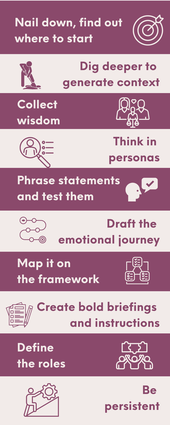When was the last time you faced a creative brief for a communication task that seemed deceptively simple on paper but felt dauntingly complex in reality?
- 'Just make it engaging'
- 'We need something different this time'
- 'Transform our strategy into action'
Sound familiar? What is true for Marketing also applies to other campaigns but still most internal or external customers lack time or interest to provide proper briefs, so most of us have developed our own methods to get behind those generic sentences. And you probably see them as part of your positioning and unique professional approach.

Recently I was asked if I would be interested in teaching an internal corporate communications team and providing a kind of methodology to add some dramaturgic
magic to their larger corporate gatherings and business events.
I admit that my instinctive thoughts were, "Why should I do this, cannibalizing project opportunities for creative service providers like myself" and "This is based on tons of experience merged
with creative personality - how can this be taught?"
But it also triggered my ambition and dealing so with AI as a thought partner daily, I KNOW that we need to say goodbye to these beliefs of being irreplaceable and building on proprietary
methodology.
In a world, where even publicly available gen AI models are capable of spitting out smart questions, brilliant ideas, and full creative concepts including implementation planning, it is exactly a
proven methodology, incorporating very human skills like empathy and sensing, that makes the difference.
As the translations in the infographic reveal, there's always more beneath the surface of a creative brief.
The art lies in systematically uncovering these layers while maintaining the purpose in mind and involving the right people.
I believe that what we often call 'creative magic' can – and should – be broken down into a reliable process.
Not to make it mechanical, but to provide a step-by-step-approach that everyone can follow and master over time.
Let me share the 10-step framework that emerged from years of experience, refined through countless projects, and now forms the backbone of how I approach every creative challenge. Each of these steps serves as both a checkpoint and a creative catalyst, they base on systemic knowledge and communication skills, but can also be enhanced with AI today.
Let's explore how they unfold...
10 StepS TO HACK THE CREATIVE BRIEF
1. Nail down and find out where to start
- Goal: Create clarity about the actual task behind the brief.
- Identify the core challenge vs. symptoms
- Map stakeholders and decision-makers
- Define success metrics early
2. Dig deeper to generate context
- Understand the organizational ecosystem
- Explore historical attempts and learnings
- Map existing resources and constraints
- Consider cultural and systemic factors
3. Collect wisdom
- Gather insights from various perspectives
- Research similar cases and solutions
- Interview key stakeholders
- Document implicit knowledge
4. Think in personas
- Create detailed audience profiles
- Map emotional and practical needs
- Consider various engagement levels
- Identify potential resistance points
5. Phrase statements and test them
- Craft clear, compelling messages
- Test assumptions with focus groups
- Iterate based on feedback
- Ensure alignment with strategy
6. Draft the emotional journey
- Map touchpoints and moments that matter
- Design peak experiences
- Plan for different engagement levels
- Consider various channels and formats
7. Map it on the framework
- Align with organizational structures
- Consider timing and resources
- Create implementation roadmap
- Build in flexibility
8. Define the roles
- Clarify responsibilities
- Identify champions and enablers
- Plan for capability building
- Create accountability structure
9. Create bold briefings and instructions
- Create clear action plans
- Develop compelling creative briefs
- Set clear expectations
- Build in checkpoints
10. Be persistent
- Stay focused on long-term goals
- Navigate resistance constructively
- Maintain momentum
- Celebrate small wins
Always remember: A solid methodology doesn't mean rigid execution. What is most important throughout the process is holding space for the unexpected moments and developments. Every project will surprise you – embrace these surprises as opportunities for growth.
And: After implementation, take time for an honest review. What worked? What didn't? These insights become invaluable building blocks for future tasks.
Like any good story, each project adds another layer of understanding to our craft.
Ready to transform your next business communication challenge into an engaging experience?
Or want to know more?
🎯 Join the upcoming Online Dramaturgy with AI Masterclass in March 2025
🤝 Schedule a discovery call to discuss your specific project
And for ongoing insights and inspiration:
📱 Follow me on LinkedIn where I regularly share case studies and tips


Write a comment